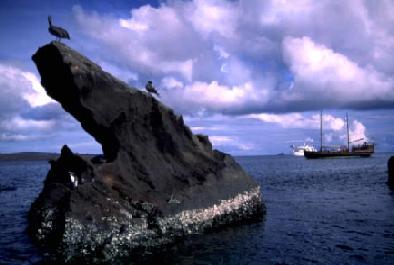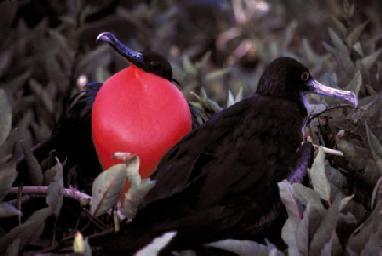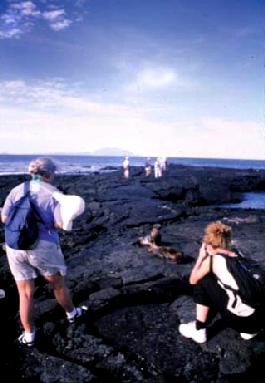Evolution in Action
Long after the floods and rains have subsided, El Nino has slipped from the world's attention span, but away from the TV cameras, sea lions and iguanas are dying in droves and warm waters are creating new turbulence for one of the planet's most precarious ecosystems
By Ron Gluckman / the Galapagos, Ecuador
Y
OU WERE GLUED TO THE TELLY UNTIL THE MESMERIZING SCENES OF DESTRUCTION and terror turned cliché: scads of bridges destroyed, miles of roads vaporized, and trillions of dollars tallied. As the world overdosed trying to digest all the dire reports about El Nino - natural phenomena of the month that long overstayed its welcome on the news scene - the only good words to be written were these: it’s over.Or is it? While El Nino has finally dropped from the world’s attention span, in one small corner of the globe, the consequences of this weather cycle remain fiercely debated, while the full impacts are still fearfully awaited.
In the Galapagos Islands, some of the planet’s rarest creatures are believed to be dying in droves. Sea lion pups wither on beaches, while flamingos slowly starve to death in marshes dotting the dark volcanic soil. Tortoises and a wide array of quirky land birds that have made the Galapagos a symbol of survival against all odds, simply aren’t breeding. And the world may be enjoying its parting view of the renowned, brilliantly contradictory, equatorial penguins.
 Perhaps the
greatest tragedy is this: nobody seems to be noticing.
Perhaps the
greatest tragedy is this: nobody seems to be noticing.
Despite its location on Indefatigable Island, that’s the feeling among resigned naturalists at the Charles Darwin Research Station, which coordinates scientific study within the "living laboratory of evolution." Says spokesperson Rosyln Cameron: "We have no idea what the exact impacts of El Nino are yet. All we can do is look back at what happened during the last major El Nino, in 1982-83."
Then, iguanas and sea lions died in the thousands. Nearly half the endemic Flightless Cormorants and 80 percent of the Galapagos Penguins perished. The Greater Flamingos nearly vanished. The islands’ Marine Iguanas - the world’s only aquatic iguanas - also suffered devastating losses.
"We’re not sure what’s happening now," concedes Cameron. "We can only speculate. We don’t even have money to go out and do observations or counts."
Despite its renown as the world’s premier biological laboratory, the islands that gave rise to Darwin’s theories of evolution three and a half centuries ago have always rolled in riches, but only the natural kind. With a staff of 70, researchers helped by loads of volunteers, the station survives on an annual budget of $1.5 to $2 million. Far greater sums are garnered by tour companies showcasing the Galapagos’ amazing array of wildlife to well-heeled visitors that yacht amongst the sprawling volcanic archipelago due west of Ecuador.
Scientists have to suffice by weighing the observations of tour guides and field researchers against the data collected following the last major El Nino, in 1982-83. Then, massive amounts of rainfall and radical warming of the unusually-cool equatorial seas prompted severe changes for life on land and in the ocean.
"Basically," says John Madunich, a naturalist with San Francisco Bay Area-based Inca Floats, who has been a guide in the Galapagos for five years, "anything living in the sea, or dependent upon it for food is going to be struggling." Warmer water means less food for these creatures, which must search farther, or deeper, to find it. Sea lions have been leaving behind pups to hunt for scarce food. "That’s what happened in the last big El Nino. Already the pups look sickly and skinny."
Rainfall in the Galapagos normally begins around February, but El Nino began unleashing torrents of rain in November, 1997. Jack Nelson, at the Hotel Galapagos, says many businesses experienced flooding. And the rain continued falling long through the next year. During 1982-83’s El Nino, rainfall totaled 12 feet; normal is about 10 inches per year on the coasts. The El Nino of 1998 may break all records. Eight inches of rain was reported by one research camp during a two-day period last December.
Even if the rains subside this summer, as expected, the threat to the Galapagos’ fragile ecosystem will continue long after El Nino is forgotten, warns Cameron. The true consequences may not be apparent for months, even years.
Since its accidental discovery in 1535 by a Spanish bishop blown off course on a voyage to Peru, the greatest threat to the Galapagos’ odd assortment of animals - many unique to the isles - has been introduced species. Many indigenous species have been wiped off islands by intruding newcomers, such as goats brought by settlers, and plants and insects they carried with them.
"Disbursement of new species in the Galapagos is our greatest worry," says Cameron. "The conditions of this El Nino just increase the chances. The added water and plant growth creates bridges across the past barriers of cactus and lava."
It has happened often enough in the past. Goats easily leapt lava barriers that kept other competitors at bay, stripping away island greenery that fed and shaded tortoise varieties. To convey how acutely some species have adapted to the absence of predators and competitors, Cameron notes that one island has five sub-species of tortoises, each endemic to a particular crater on that isle.
Add an insect, or change a plant habitat, and the entire food chain can crumble apart. "Everything here is extremely critical," Cameron says. "The ecosystem here is so fragile and special, we see danger everywhere."
This explains why visitors are grilled about importing fruits or plants onto the islands, which constitute Ecuador’s first national park, designated a World Heritage site in 1978. Travel around the islands is by registered tour boats, with park-trained naturalists guiding visits to a small number of sites on designated islands. Costs are in the range of US$150 to US$400 per day.
Still, visiting the Galapagos remains one of the world’s true wonders, and El Nino has had little impact on the attractions. Indeed, warmer weather through the recent cool season has pleased many visitors. And the added greenery has actually boosted some populations, particularly of land birds.
Richard and Pat Swire, a retired couple Lake George, New York, liked the rich variety of wildlife, and their ability to get so close to it. This quality of has been noted by Galapagos visitors for centuries; because of the lack of predators, the birds and other creatures of the islands have no fear of guests. "You can walk right up and get great pictures," Richard enthuses.
Videos and brochures tout this peculiarity, but nothing prepares visitors for the real thing. Save your telephoto lenses for the game parks. In the Galapagos, a point-and-shoot produces poster prints of some of the world’s rarest and most entertaining animals.
These include the Flightless Cormorant, which most likely flew to the island, than shed its wings in an evolutionary flourish. Nowadays, it has no use for its stunted wings, as it swims underwater to catch fish.
The islands have three varieties of exotic booby birds - red-footed, blue-footed and masked. No sight is more breathtaking than watching these ungainly birds circle high over the sea, until they suddenly drop straight down, kamikaze style, to snare fish.
The islands host 11 unique subspecies of Giant Tortoise, including some nearly as big as a VW Bug. There are scores of endemic iguanas, snakes and lizards including seven species of the Lava Lizard, with lava-colored markings.
Then, there are a baker’s dozen Finch species that prompted Darwin’s earth-changing theory of evolution. Each finch variety adapted to conditions on its own island, often radically. The Woodpecker Finch holds twigs in its beak to dig for insects in trees. Charles Darwin, who sailed here aboard the H.M.S Beagle in 1832, reflected upon these strange animals for a quarter century before issuing his landmark, "The Origin of Species."
 Visitors can
still feel a sense of standing in Darwin’s shoes when they visit the pristine
islands, observing thought-provoking animal behavior at close hand. Perhaps the most
mesmerizing sights are the magical mating rituals.
Visitors can
still feel a sense of standing in Darwin’s shoes when they visit the pristine
islands, observing thought-provoking animal behavior at close hand. Perhaps the most
mesmerizing sights are the magical mating rituals.
The Great Frigate is a huge black bird. The males park in trees, where they watch females cruise overhead during courting season. As the females appear, the males quickly puff up huge bright-red pouches to the size of big balloons. The females select the most pumped-up males for breeding.
Most sea birds engage in exotic mating rituals, but none as memorable as the Waved Albatross. Another huge bird, the albatross does a wild courtship tango that can consume hours. Interested males and females circle each other, one whistling while the other hoots an ear-splitting reply. As they grow aroused, they spin closer, till they are almost touching, then they twist their long necks straight up, and begin whacking beaks together in a sensuous sword fight. Then, they back up and start the dance all over again.
The blue-footed boobies do another magical waltz, but foreplay is footplay - slow, erotic prancing. The male lifts up one webbed foot, than the other, showing them to the female, over and over, in slow motion. If his footish display arouses the female, they move closer, amidst much chortling, and begin clanging beaks together, too.
Bookshelves are filled with studies of the islands’ legendary adaptive behavior. Standing out on this stage requires amazing evolutionary trickery. Take the case of the Marine Iguana, which subsists on a diet of seaweed. Nothing remarkable about that, except the stuff is indigestible in its raw form. This miniature Godzilla of the Sea swims around stuffing himself with seaweed, then climbs ashore and sits in the sun. His body becomes a roasting pot. When dinner is cooked, he consumes it.
Pondering these marvels of nature is part of the magic of every Galapagos visit, from Darwin onwards. Author Kurt Vonnegut was so inspired that, after a long absence from writing, he returned with the novel, "Galapagos," detailing more than a million years of human evolution.
In all, the Galapagos consists of about 20 islands spread out over 17,000 square miles. Over a dozen islands are open to visitation, but only the most extensive itineraries take in them all. Most tours, ranging in price from US$400-$1,200, visit four or five islands during a 3-4 day tour.
The Swire’s opted for an expansive 10-day itinerary arranged by Inca Floats, a San Francisco-area firm that has been involved in the Galapagos for decades. Touring was aboard the Eric, an 84-foot yacht capable of carrying up to 20 passengers in relatively luxurious conditions.
 Even the
cheapest tours are all-inconclusive, although food and lodging varies widely, as does the
quality of guide service. But the schedule is mostly the same. Following breakfast on
board, visitors are given a briefing about the island site before landing. A second
landing, at another site on the island, or upon a nearby one, follows lunch. In between,
are on-board nature programs and swimming.
Even the
cheapest tours are all-inconclusive, although food and lodging varies widely, as does the
quality of guide service. But the schedule is mostly the same. Following breakfast on
board, visitors are given a briefing about the island site before landing. A second
landing, at another site on the island, or upon a nearby one, follows lunch. In between,
are on-board nature programs and swimming.
This is another thing the brochures don’t properly illuminate. Pictures focus upon the goofy Galapagos animals. Until you visit, you never see the marvelous beaches: combed-white sand, olive, or black volcanic rock. They sit in palm-sheltered coves, with spectacular snorkeling nearby.
The Galapagos Islands sit within ocean currents that bring the equator’s coldest water. The seas teem with wildlife. During our visit, we spotted whales, sharks, countless schools of colorful fish, and an enormous, Stealth Bomber-like Manta Ray. We also swam with penguins and playful sea lions.
Any time is good for visits, but most plan around the weather or the species they want to see. Hot season is January to May - and it can be scorching on the equator. This is also rainy season. Cool season is June-December. Fish are more abundant in the cold, but snorkeling is more comfortable in the warm season. Marine turtles tend to be on hand November-February, while sea lion pups are irresistibly cute just after birth, in December and January. But they are most playful in May, when you can swim with swarms of 50 or more at once.
Birders prefer the transition period between the seasons, when the nesting and courtship rituals are at their height. Frigates are puffing up pouches in March, while the albatross begins its erotic dance routine in April.
Despite dire notes over the possible damage caused by this El Nino, the storm system may provide yet even more allure to Galapagos. Madunich notes that the real marvel of El Nino was missed by a world bombarded with pictures of mudslides and road damage. "This is a normal weather condition that comes every year," says Madunich. "It’s just another part of nature."
He says there may be a silver lining, even to this storm. During the last El Nino, nothing was left on one island for finches to feed upon except big, hard seeds. Naturalists witnessed a rare spectacle as the very bird species that inspired Darwin’s revolutionary theories, again unveiled the evolutionary process of natural selection before their eyes.
"Birds with smaller beaks couldn’t crack the seeds," he says, "so they didn’t survive. The birds evolved and now have bigger, deeper beaks."
Such adaptation is rare, but in the Galapagos, life has taken unconventional paths, and preserved. That’s the great lesson of this "living laboratory of evolution." In the aftermath of El Nino, the test results are still out for these unusual islands, where the impacts have shaken the earth in the past.
Ron Gluckman is an American journalist based in Hong Kong, who generally roams around the Asia region. He spent parts of 1997 and 1998 in Latin America, where he researched and wrote this story, which appeared in varying form in several publications in the summer of 1998.
Pictures are by Ron Gluckman and Jolanda
For more information on tours through the Galapagos visit the excellent website of Inca Floats at www.incafloats.com or contact IncaFloats at IncaFloats@aol.com or the Galapagos Network at gpsnet@aol.com
For information on the Galapagos, visit the Charles Darwin Research Station web site at http://www.polaris.net/~jpinson/welcome.html
To return to the opening page and index
push here
[right.htm]
